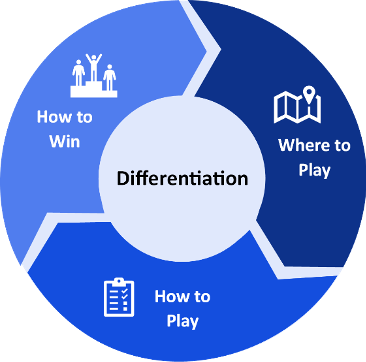The cornerstone of a successful business is a growing business. However, in the competitive world of today’s B2B companies, determining where that growth might come from and how to capitalize on it is often a challenge. Even for businesses in the fortunate situation of having clear growth paths in expanding markets, creating a comprehensive strategy that drives the entire organization in a unified direction can often be an overwhelming task. In this blog, we will walk through our framework for creating a differentiated growth strategy to unite your organization and set the stage for success.

Where to Play, How to Play, and How to Win
When crafting a strategy built on differentiation, there are three foundational elements to consider: Where to Play, How to Play, and How to Win. By considering each one of these elements, organizations can create a holistic strategic plan that is easy to communicate.

Where to Play – At the highest level, creating a growth strategy begins by defining which markets, market segments, and sub-segments the organization will target for growth. While in some cases these markets present themselves clearly, in other cases defining where to play can be challenging. A common difficulty is targeting the market segment that is right for your organization and not just the largest or fasting growing segment. While in some cases these might align, there are many times when they do not.
How to Play – When defining areas of opportunity, organizations can also begin to identify the offers (i.e. the products, services, or solutions) they will use to capitalize on those markets. In some cases, existing offers may resonate well with new positioning and strong go-to-market efforts. Other times, however, organizations may look to center their strategy around new offers.
How to Win – This final cog in the wheel represents where the rubber meets the road for an organization’s growth strategy. Now that a market segment and relevant offers have been identified, leaders can begin to identify ways that they can enter the market in a differentiated manner. Some organizations might benefit by acquiring or partnering with existing players in the space, others by transforming their selling methods and approach to the customer. Regardless of the methodology, organizations will be compelled to differentiate themselves to win in their new market segment.
Strategy Creation and Customer Intimacy
Without Customer Intimacy, each piece of the strategy creation puzzle can feel challenging if not impossible. As your organization looks to define its strategy, it may be helpful to keep the following customer intimacy related questions in mind.
Where to Play
- What are the most pressing challenges and problems to be solved?
- Where should we be operating that we are not today?
- Where does the market expect us to operate?
- Which markets are too far away from my core business model to operate in?
How to Play
- What offers does the market need right now?
- Why is the market looking for those types of offers?
- What offers does the market expect my organization to be offering?
How to Win
- How do I differentiate myself in these segments?
- What competition exists in this segment with similar offers? How will I overcome that competition?
- How is the product or service differentiated?
- How can my sales and marketing approach cut through the clutter?
- How can I create lasting relationships with accounts?
Conclusion
A well-defined growth strategy is the bedrock of success. The decisions of Where to Play, How to Play, and How to Win are foundational components of a growth strategy embedded with differentiation. However, a nagging question may still remain no matter how well you feel you have accomplished creating your strategy – what if I was wrong? What if my strategy is not the right strategy? The reality may come as a relief (or a disappointment in some cases); you are not likely to be 100% correct. That said, success does not require 100% accuracy, and organizing the strategy is only the beginning. In our next blog, we will discuss the alignment that helps teams to ensure a growth strategy’s success.
Written by: Mark Slotnik and Jack Draeb
Mark Slotnik has spent nearly 20+ years advising clients in the areas of designing and taking to market high-value business solutions, solution portfolio management, talent development, resource management, business process re-engineering and commercial software.
Jack Draeb is a Senior Consultant with McMann & Ransford who has experience working with Fortune 1000 companies to identify issues, define solutions, guide change management, and deliver lasting results.
